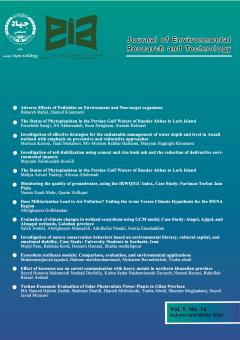بررسی تثبیت خاک با استفاده از سیمان و خاکستر پوسته برنج و کاهش اثرات مخرب زیستمحیطی
الموضوعات : environmental economy
1 - استادیار، گروه مهندسی عمران، دانشکده فنی و مهندسی، دانشگاه گیلان، ایران
الکلمات المفتاحية: تثبیت, بهسازی, پوزولان, خاکستر پوسته برنج,
ملخص المقالة :
با توجه بهضرورت استفاده از مصالح تجدیدپذیر و دوستدار محیطزیست، این پژوهش به بررسی جامع خاکستر پوسته برنج بهعنوان یک جایگزین پایدار برای سیمان پرداختهاست. انتخاب این ماده بهدلیل ویژگیهای منحصر به فردی از جمله فعالیت پوزولانی بالا، فراوانی و دسترسی آسان در منطقه، هزینه تولید پایین و مزایای زیستمحیطی بوده است. در این مطالعه، پس از مروری بر تاریخچه و مبانی تثبیت خاک، فرآیند تولید و عملآوری خاکستر پوسته برنج در دمای کنترل شده مورد بررسی قرار گرفته است. مشخصات شیمیایی و مورفولوژیکی این ماده با استفاده از روشهای پیشرفته آزمایشگاهی از جمله پراش اشعه ایکس (XRD) و میکروسکوپ الکترونی روبشی (SEM) ارزیابی شده است. نتایج تحقیق نشانمیدهد که جایگزینی 20 تا 30 درصدی سیمان با خاکستر پوسته برنج موجب دستیابی به مقاومت فشاری در حدود 90 تا 95 درصد نمونههای شاهد میشود. همچنین، استفاده از این ماده بهعنوان یک پوزولان طبیعی علاوه بر بهبود مشخصات ژئوتکنیکی خاک شامل افزایش مقاومت برشی و کاهش پتانسیل تورم، منجر به کاهش 40 تا 45 درصدی مصرف سیمان و در نتیجه کاهش انتشار گازهای گلخانهای به میزان تقریبی 5/0 تن دیاکسید کربن بهازای هر تن سیمان جایگزین شده میشود. از منظر زیستمحیطی، بهکارگیری این ماده نهتنها مشکل دفع پسماندهای کشاورزی را حل میکند، بلکه گامی مؤثر در جهت توسعه پایدار و حفظ منابع طبیعی محسوب میشود.
Nair, D. G., Fraaij, A., Klaassen, A. A., & Kentgens, A. P. (2008). A structural investigation relating to the pozzolanic activity of rice husk ashes. Cement and concrete research, 38(6), 861-869.
Ghorbani, A., & Salimzadehshooiili, M. (2019). Dynamic characterization of sand stabilized with cement and RHA and reinforced with polypropylene fiber. Journal of Materials in Civil Engineering, 31(7), 04019095.
Salimzadehshooiili, M. (2023). Investigation of the effect of frequency on shear strength and damping of pure sand and sand stabilised with rice husk ash using cyclic triaxial tests. Advances in Civil and Architectural Engineering, 14(26), 25-39.
Sata, V., Jaturapitakkul, C., & Kiattikomol, K. (2007). Influence of pozzolan from various by-product materials on mechanical properties of high-strength concrete. Construction and building materials, 21(7), 1589-1598.
Salas, A., Delvasto, S., de Gutierrez, R. M., & Lange, D. (2009). Comparison of two processes for treating rice husk ash for use in high performance concrete. Cement and concrete research, 39(9), 773-778.
Sezer, A., İnan, G., Yılmaz, H. R., & Ramyar, K. (2006). Utilization of a very high lime fly ash for improvement of Izmir clay. Building and environment, 41(2), 150-155.
Ingles, O. G., & Metcalf, J. B. (1972). Soil stabilization principles and practice (Vol. 11, No. Textbook).
Mallela, J., Quintus, H. V., & Smith, K. (2004). Consideration of lime-stabilized layers in mechanistic-empirical pavement design. The National Lime Association, 200(1), 1-40.
Sherwood, P. T. (1962). Effect of sulfates on cement-and lime-stabilized soils. Highway Research Board Bulletin, (353).
Hunter, D. (1988). Lime-induced heave in sulfate-bearing clay soils. Journal of geotechnical engineering, 114(2), 150-167.
McKennon, J. T., Hains, N. L., & Hoffman, D. C. (1994). Method for stabilizing clay bearing soils by addition of silica and lime. Patent Cooperation Treaty (PCT), Patent Classification: C09K, 17(00).
Della, V. P., Kühn, I., & Hotza, D. (2002). Rice husk ash as an alternate source for active silica production. Materials letters, 57(4), 818-821.
Anwar, M., Miyagawa, T., & Gaweesh, M. (2000). Using rice husk ash as a cement replacement material in concrete. In Waste management series (Vol. 1, pp. 671-684). Elsevier.
Ramakrishna, A. N., & Pradeepkumar, A. V. (2006). Stabilization of black cotton soil using rice husk ash and cement. In National conference on Civil Engineering meeting the challenges of tomorrow, GND Engineering college, Ludhiana (pp. 215-220).
Tashima, M. M., Silva, C. A. R., Akasaki, J. L., & Barbosa, M. B. (2004, November). The possibility of adding the rice husk ash (RHA) to the concrete. In the Proceedings of the 2004 International RILEM Conference on the Use of Recycled Materials in Building and Structures (pp. 778-786).
Zhang, M. H., Lastra, R., & Malhotra, V. M. (1996). Rice-husk ash paste and concrete: some aspects of hydration and the microstructure of the interfacial zone between the aggregate and paste. Cement and concrete Research, 26(6), 963-977.
Smith, R. G., & Kamwanja, G. A. (1986, October). The use of rice husk for making a cementitious material. In Proc. Joint Symposium on the Use of Vegetable Plants and their Fibers as Building Material, Baghdad.
Little, D. N., & Little, D. N. (1987). Soil stabilization for roadways and airfields. Engineering & Services Laboratory, Air Force Engineering & Services Center.
Clough, G. W., Sitar, N., Bachus, R. C., & Rad, N. S. (1981). Cemented sands under static loading. Journal of the Geotechnical Engineering Division, 107(6), 799-817.
Bhattacharja, S. A. N. K. A. R., Bhatty, J. I., & Todres, H. A. (2003). Stabilization of clay soils by Portland cement or lime–a critical review of literature. PCA R&D Serial, 60(1), 124-133..
Ismail, M. A., Joer, H. A., Sim, W. H., & Randolph, M. F. (2002). Effect of cement type on shear behavior of cemented calcareous soil. Journal of geotechnical and geoenvironmental engineering, 128(6), 520-529.
Herzog, A., & Mitchell, J. K. (1963). Reactions accompanying stabilization of clay with cement. Highway Research Record, (36).
Geiman, C. M. (2005). Stabilization of soft clay subgrades in Virginia phase I laboratory study (Doctoral dissertation, Virginia Tech).
Feng, Q., Yamamichi, H., Shoya, M., & Sugita, S. (2004). Study on the pozzolanic properties of rice husk ash by hydrochloric acid pretreatment. Cement and concrete research, 34(3), 521-526.


